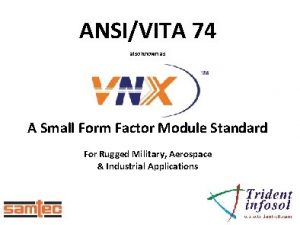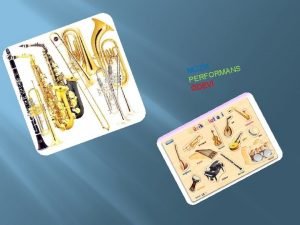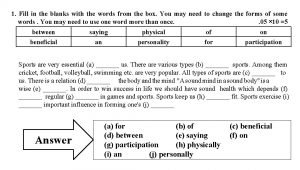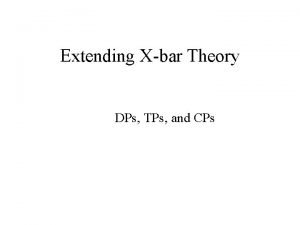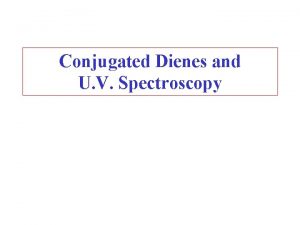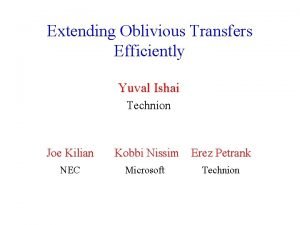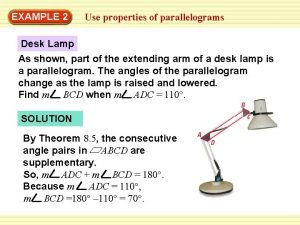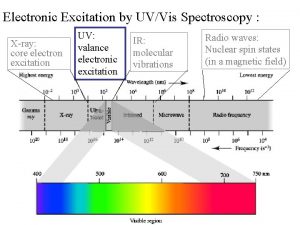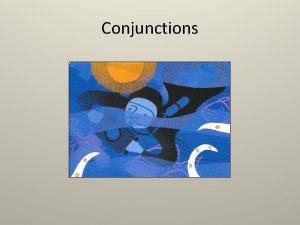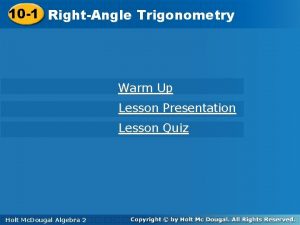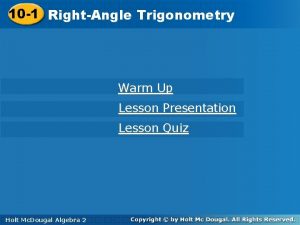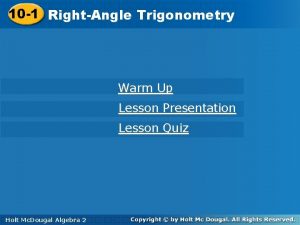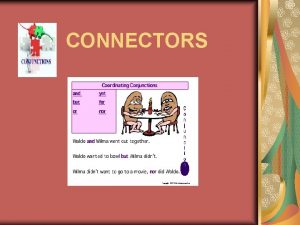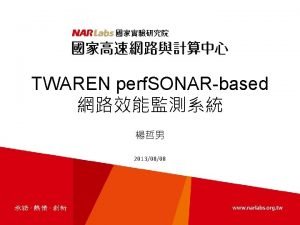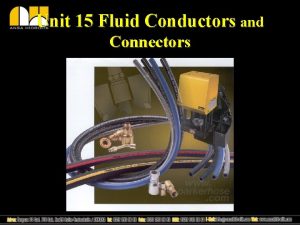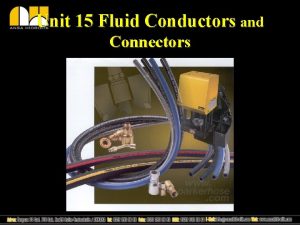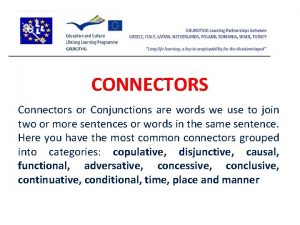EXTENDING SI PERF IN RIGHTANGLE VNX CONNECTORS USING
































- Slides: 32

EXTENDING SI PERF IN RIGHT-ANGLE VNX CONNECTORS USING GROUND MODE RESONANCE SUPPRESSION PRESENTED BY: BURRELL BEST VSO MEETING - SAN PEDRO, CA - JULY 2018

AGENDA • Problem, Objective, & Summary • Test Board Design Overview • PCIe Simulation Performance Summary • De-embedded Measurement Results • Conclusions • Back-up

PROBLEM High-density open pin-field designs offer flexibility to system designers, but with limitations above 10 Gbps. • Open pin field designs are inherently prone to resonances originating through the ground pin connections. This is commonly called ground mode resonance (GMR). • Because of varying pin lengths in right-angle connectors, GMR will effect each row differently. • GMR must be considered when designing channels above 10 Gbps using open pin field RA VNX connectors. •

OBJECTIVE • Demonstrate Resonance Suppression: Show that resistors dampen sharp resonances in the frequency domain. • Show improvements in signal eye height and eye width. • Show that higher frequency applications are possible with VNX Right Angle connectors when using damping resistors. • • Analyze Performance: Using the SEASIM (0. 74) simulation tool, characterize PCIe G 4/G 5 channel performance using the SEARAY™ Right Angle (RA) connectors. • Compare the performance with/without suppression resistors. •

SUMMARY • De-embedded connector models used in simulations confirm that improvements in the connectors performance are realized when the suppression resistors are used. • This can be observed in both the connector frequency domain measurements and the channel simulation results. • Resonances are more prevalent for the longer pin paths without damping resistors. • With damping resistors, Samtec’s right angle SEARAY™ connector can pass channels up to and including PCIE Gen 5 (32 GT/s).

TEST BOARD DESIGN OVERVIEW

TEST BOARD DESIGN OVERVIEW • Board Material – Isola 1067 • 2” 100Ω differential strip lines • Traces isolated by ground Vias • 2. 92 mm SMA ports • 10Ω damping resistors were installed on the back side of both boards. • Signal Vias back drilled to reduce stub resonances

APPROXIMATE EQUIVALENT CIRCUIT Ground return damping resistors

EXAMPLE OF RESISTOR PLACEMENT Note: Routing channel reduced, but still routable

TEST BOARD WIRING DIAGRAM • Signaling order ‘SSGGSS’ and ‘GGSSGG’ • Electrical length increases from row A to H 6 5 4 3 2 1 Row NC NC gnd NC NC H gnd p 207 p 199 gnd G p 222 p 214 gnd gnd F gnd p 205 p 197 gnd E NC NC gnd NC NC D NC NC NC C B A H A

PCIE SIMULATION PERFORMANCE SUMMARY

PCIE GEN 4 (FR 4) – XTALK SIMULATION Module 1 Victim Resistor EH EW Meet Spec P 214, P 222 No 75. 3 m. V . 546 UI Yes P 214, P 222 Yes 75. 4 m. V 0. 558 UI Yes G 4 Passing Criteria: • EH > 15. 0 m. V • EW > 0. 3 UI Len 1 = 4” Len 2 = 4” Backplan e Victim 6 5 4 3 NC NC gnd gnd p 222 Aggresso rs 2 1 Row gnd NC NC H p 207 p 199 gnd G p 214 gnd NC NC F gnd p 205 p 197 gnd E NC NC gnd NC NC D NC NC NC C

PCIE GEN 4 (FR 4) – PERFORMANCE BY PIN PAIR Without Resistors Pins Module 1 EH EW 197, 205 (Short) 83. 9 m. V 0. 546 214, 222 (Med) 76. 8 m. V 0. 551 199, 207 (Long) 75. 6 m. V 0. 518 Modest Improvement With Resistors Len 1 = 4” Pin Pairs Len 2 = 4” Backplan e G 4 Passing Criteria: • EH > 15. 0 m. V • EW > 0. 3 UI EH EW EH ∆ EW ∆ 197, 205 (Short) 81. 6 m. V 0. 558 -2. 8% +2. 2% 214, 222 (Med) 78. 7 m. V 0. 565 +2. 4% +2. 5% 199, 207 (Long) 79. 8 m. V 0. 575 +5. 3% +11. 0%

PCIE GEN 5 (FR 4) – XTALK SIMULATION Module 1 Victim Resistor EH EW Meet Spec P 214, P 222 No 10. 8 m. V 0. 195 UI No P 214, P 222 Yes 24. 0 m. V 0. 358 UI Yes G 5 Passing Criteria: • EH > 10. 0 m. V • EW > 0. 3 UI Len 1 = 4” Len 2 = 4” Backplan e Victim 6 5 4 3 NC NC gnd gnd p 222 Aggresso rs 2 1 Row gnd NC NC H p 207 p 199 gnd G p 214 gnd NC NC F gnd p 205 p 197 gnd E NC NC gnd NC NC D NC NC NC C

PCIE GEN 5 SIMULATION (FR 4) – PERFORMANCE COMPARISON BY PIN PAIR Without Resistors Pins Module 1 EH EW 197, 205 (Short) 24. 2 m. V 0. 329 214, 222 (Med) 15. 2 m. V 0. 245 199, 207 (Long) 15. 8 m. V 0. 240 Exceptional Improvement With Resistors Len 1 = 4” Pin Pairs Len 2 = 4” Backplan e G 5 Passing Criteria: • EH > 10. 0 m. V • EW > 0. 3 UI EH EW EH ∆ EW ∆ 197, 205 (Short) 32. 5 m. V 0. 403 +34% +23% 214, 222 (Med) 31. 8 m. V 0. 410 +109% +67% 199, 207 (Long) 31. 4 m. V 0. 400 +99% +67%

SEARAY™ (RA) MATED CONNECTOR RESULTS • The effect of the damping resistors in the Gen 4 simulation is to increase the eye-width up to +11% while having a small effect on the eye-height. • The effect of the damping resistors in the Gen 5 simulation is astonishing, yielding eye-height improvements of +109% and eye-width improvements of +67%. • This is achieved by the reduction of the jitter in the rising and falling edges by the resistor damping elements. • The addition of damping resistors improves the SEARAY™ RA performance enough to pass PCIE Gen 5 (32 GT/s) channels.

DE-EMBEDDED MEASUREMENT RESULTS

SETUP FOR SEARAY™ MEASUREMENTS • Keysight N 5227 A 67 GHz Microwave Network Analyzer for Return Loss, Insertion Loss and Crosstalk (NEXT and FEXT) measurements. • Two test boards (one populated with damping resistors) and a calibration board • The SEARAY™ Connector S-parameter models were extracted from VNA measurements using a 2 x thru style de-embedding tool.

DE-EMBEDDED INSERTION (IL) COMPARISON • Resonances get sharper with pin length through the connector • RED Plots with Resistors Long 4 Mediu m p 222 3 2 1 Row p 207 p 199 G p 214 F p 205 p 197 E Short

DE-EMBEDDED CONNECTOR MEASUREMENTS - IL With 10Ω Dampening Resistor Note: Reduced resonance spikes PCIe Gen 4 Data Rate 16 Without

DE-EMBEDDED CONNECTOR MEASUREMENTS – RL With 10Ω Dampening Resistor Without

DE-EMBEDED CONNECTOR MEASUREMENTS – NEXT With 10Ω Dampening Resistor Without

DE-EMBEDDED CONNECTOR MEASUREMENTS – FEXT With 10Ω Dampening Resistor Without

PCIE GEN 5 SIMULATION (FR 4) – PERFORMANCE COMPARISON BY PIN PAIR Without Resistors Pins Module 1 EH EW 197, 205 (Short) 24. 2 m. V 0. 329 214, 222 (Med) 15. 2 m. V 0. 245 199, 207 (Long) 15. 8 m. V 0. 240 Exceptional Improvement With Resistors Len 1 = 4” Pin Pairs Len 2 = 4” Backplan e G 5 Passing Criteria: • EH > 10. 0 m. V • EW > 0. 3 UI EH EW EH ∆ EW ∆ 197, 205 (Short) 32. 5 m. V 0. 403 +34% +23% 214, 222 (Med) 31. 8 m. V 0. 410 +109% +67% 199, 207 (Long) 31. 4 m. V 0. 400 +99% +67%

PCIE GEN 5 SIMULATION (MEG 6) – PERFORMANCE COMPARISON BY PIN PAIR Without Resistors Pins Module 1 EH EW 197, 205 (Short) 37. 1 m. V 0. 279 214, 222 (Med) 16. 2 m. V 0. 145 199, 207 (Long) 26. 5 m. V 0. 219 G 5 Passing Criteria: • EH > 10. 0 m. V • EW > 0. 3 UI Exceptional Improvement With Resistors Len 1 = 4” Pin Pairs Len 2 = 4” Backplan e EH EW EH ∆ EW ∆ 197, 205 (Short) 52. 7 m. V 0. 350 +54 % + 25 % 214, 222 (Med) 45. 1 m. V 0. 340 +178 % +134 % 199, 207 (Long) 44. 9 m. V 0. 320 +69 % + 48 %

CONCLUSIONS • The use of damping resistors is a great way to suppress the high frequency resonances visible in the SEARAY™ RA measurements. • Simulation results confirm that significant eye-height and eyewidth improvements are realized when the damping resistors are used. • The magnitude of the improvements scale proportionally with the data rate. Meaning that higher data rates show greater improvement. • With the use of ground return damping resistors Samtec’s SEARAY™ RA connector should be considered for Gen 4 (16 GT/s) and Gen 5 (32 GT/s) PCIE channels.

UOY KNAHT

BACK-UP

PCIE SEASIM TOOL PARAMETERS • Statistical Eye Analysis Simulator (SEASIM v 0. 74) • Tx/Rx Equalization: Adaptive • Pkg Model: PCIE Gen 4 reference pkgs used by PCI SIG • Board Material: FR 4 (Er=4. 3, Tan. D=0. 012) • T-line Model: Differential 85Ω / 100Ω Striplines solved with HFSS • Connector Model: De-embedded from actual measured data, includes the breakout region (BOR) from the connector pin field. • VIAs: No Via was used to connect the Packages to the T-line. Vias are present in the connector model. • Xtalk: Cross talk components in the striplines and connector were not added.

RIGHT ANGLE SEARAY™ RECEPTACLE AND BACKPLANE CONNECTOR SEAF-RA �Female Right Angle Design � 0. 050” (1. 27 mm) pitch �P/N: S-SEAF-50 -01 -L-08 -2 -RA-GP-TR SEAM �Male Vertical Backplane Design � 0. 050” (1. 27 mm) pitch �Guide post option �P/N: S-SEAM-50 -2. 0 -S-08 -2 -A-GP-K-TR

STACKUP

END
 Documentum trusted content services
Documentum trusted content services Vnx form factor
Vnx form factor Perf internet
Perf internet Ask model
Ask model Perf expert
Perf expert Dns perf test
Dns perf test Perf rmans
Perf rmans 1. fill in
1. fill in Mendelian genetics vocabulary
Mendelian genetics vocabulary Problem 8-3 extending amounts across the work sheet
Problem 8-3 extending amounts across the work sheet Extending surface area and volume
Extending surface area and volume Dps tps
Dps tps Karyotype
Karyotype Uv spectra of dienes
Uv spectra of dienes A pointed piece of land extending into the sea
A pointed piece of land extending into the sea Extending oblivious transfers efficiently
Extending oblivious transfers efficiently Parallelogram lamp
Parallelogram lamp Section 1 chromosomes and phenotype study guide a
Section 1 chromosomes and phenotype study guide a Xbar theory
Xbar theory X bar theory
X bar theory Extending mendelian genetics chapter 7
Extending mendelian genetics chapter 7 Punnett square color blindness
Punnett square color blindness A high point of land extending into water
A high point of land extending into water Emerging proficient extending
Emerging proficient extending What are landforms
What are landforms Uv xray
Uv xray Using system using system.collections.generic
Using system using system.collections.generic Dtfd switch
Dtfd switch Common audio connectors
Common audio connectors How to start a summary
How to start a summary These are words that are called joiners or connectors.
These are words that are called joiners or connectors. Zagmi
Zagmi Power platform data connectors
Power platform data connectors

